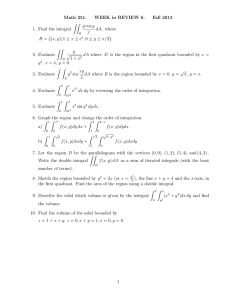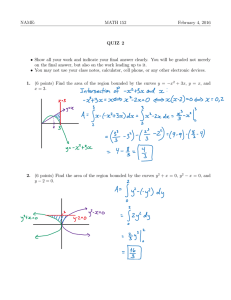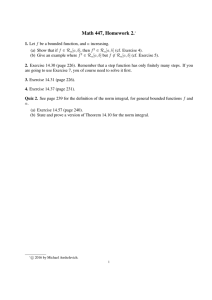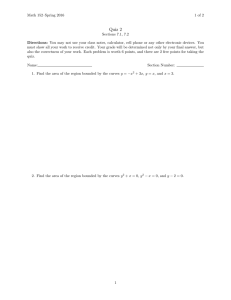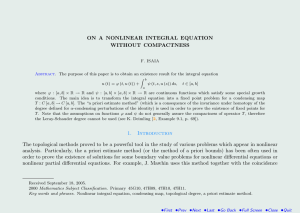233 ON A NONLINEAR INTEGRAL EQUATION WITHOUT COMPACTNESS
advertisement
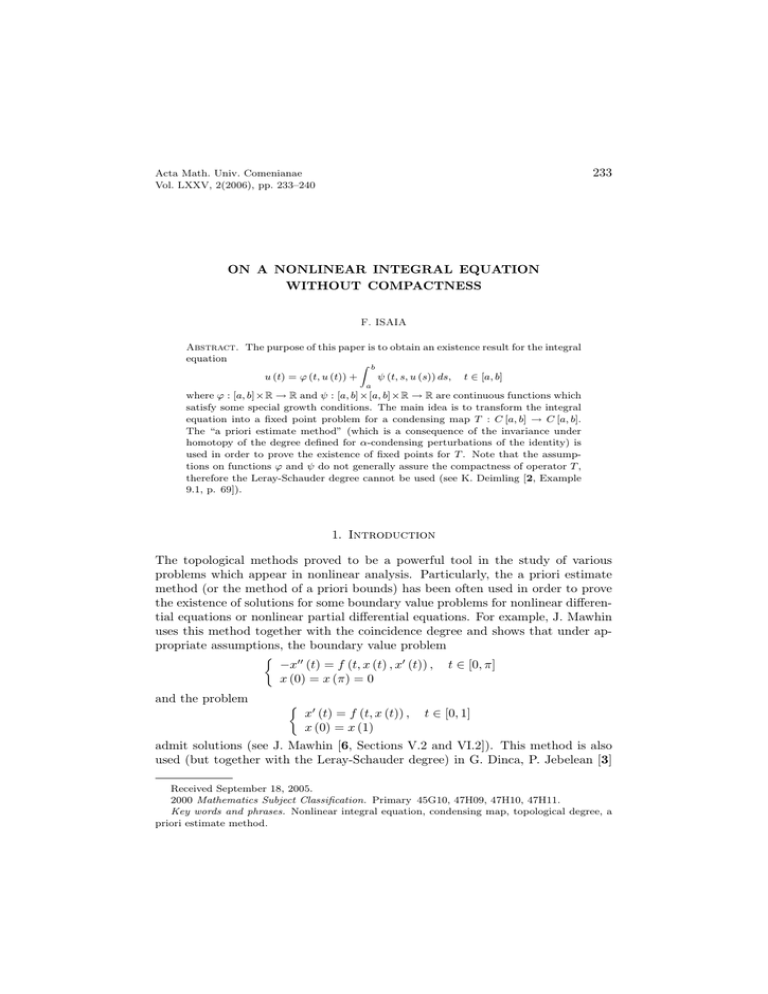
233
Acta Math. Univ. Comenianae
Vol. LXXV, 2(2006), pp. 233–240
ON A NONLINEAR INTEGRAL EQUATION
WITHOUT COMPACTNESS
F. ISAIA
Abstract. The purpose of this paper is to obtain an existence result for the integral
equation
Z b
u (t) = ϕ (t, u (t)) +
ψ (t, s, u (s)) ds, t ∈ [a, b]
a
where ϕ : [a, b] × R → R and ψ : [a, b] × [a, b] × R → R are continuous functions which
satisfy some special growth conditions. The main idea is to transform the integral
equation into a fixed point problem for a condensing map T : C [a, b] → C [a, b].
The “a priori estimate method” (which is a consequence of the invariance under
homotopy of the degree defined for α-condensing perturbations of the identity) is
used in order to prove the existence of fixed points for T . Note that the assumptions on functions ϕ and ψ do not generally assure the compactness of operator T ,
therefore the Leray-Schauder degree cannot be used (see K. Deimling [2, Example
9.1, p. 69]).
1. Introduction
The topological methods proved to be a powerful tool in the study of various
problems which appear in nonlinear analysis. Particularly, the a priori estimate
method (or the method of a priori bounds) has been often used in order to prove
the existence of solutions for some boundary value problems for nonlinear differential equations or nonlinear partial differential equations. For example, J. Mawhin
uses this method together with the coincidence degree and shows that under appropriate assumptions, the boundary value problem
−x00 (t) = f (t, x (t) , x0 (t)) , t ∈ [0, π]
x (0) = x (π) = 0
and the problem
x0 (t) = f (t, x (t)) ,
x (0) = x (1)
t ∈ [0, 1]
admit solutions (see J. Mawhin [6, Sections V.2 and VI.2]). This method is also
used (but together with the Leray-Schauder degree) in G. Dinca, P. Jebelean [3]
Received September 18, 2005.
2000 Mathematics Subject Classification. Primary 45G10, 47H09, 47H10, 47H11.
Key words and phrases. Nonlinear integral equation, condensing map, topological degree, a
priori estimate method.
234
F. ISAIA
and G. Dinca, P. Jebelean, J. Mawhin [4] to prove the existence of solutions for
the problem
−∆p u = f (t, u) in Ω
u |∂Ω = 0.
In the present paper, the a priori estimate method is used together with the
degree for condensing maps in order to prove the existence of solutions for the
integral equation
Z b
(1)
u (t) = ϕ (t, u (t)) +
ψ (t, s, u (s)) ds, t ∈ [a, b] ,
a
under appropriate assumptions on functions ϕ and ψ. The result presented herein
is in relation with a result of F. Isaia [5]. The hypothesis imposed on functions ϕ
and ψ are stronger (and considerably simpler), but the result is stronger as well,
namely the solution u of equation (1) is in C [a, b], while in F. Isaia [5], we obtained
u ∈ Lp (a, b).
2. The topological degree for condensing maps
For a minute description of the following notions we refer the reader to K. Deimling
[2].
In the following, X will be a Banach space and B ⊂ P (X) will be the family
of all its bounded sets.
Definition 1. The function α : B → R+ defined by
α (B) = inf {d > 0 : B admits a finite cover by sets of diameter ≤ d} ,
B ∈ B,
is called the (Kuratowski-) measure of noncompactness.
In the whole paper, the letter α will only be used in this context. We state
without proof some properties of this measure.
Proposition 1. The following assertions hold:
(a) α (B) = 0 iff B is relatively compact.
(b) α is a seminorm, i.e.
α (λB) = |λ| α (B)
and
α (B1 + B2 ) ≤ α (B1 ) + α (B2 ) .
(c) B1 ⊂ B2 implies α (B1 ) ≤ α (B2 );
α (B1 ∪ B2 ) = max {α (B1 ) , α (B2 )} .
(d) α (convB)
= α (B).
(e) α B = α (B).
Definition 2. Consider Ω ⊂ X and F : Ω → X a continuous bounded map.
We say that F is α-Lipschitz if there exists k ≥ 0 such that
α (F (B)) ≤ kα (B)
(∀) B ⊂ Ω bounded.
ON A NONLINEAR INTEGRAL EQUATION WITHOUT COMPACTNESS
235
If, in addition, k < 1, then we say that F is a strict α-contraction. We say that F
is α-condensing if
α (F (B)) < α (B)
(∀) B ⊂ Ω bounded with α (B) > 0.
In other words, α (F (B)) ≥ α (B) implies α (B) = 0. The class of all strict
α-contractions F : Ω → X is denoted by SCα (Ω) and the class of all α-condensing
maps F : Ω → X is denoted by Cα (Ω).
We remark that SCα (Ω) ⊂ Cα (Ω) and every F ∈ Cα (Ω) is α-Lipschitz with
constant k = 1. We also recall that F : Ω → X is Lipschitz if there exists k > 0
such that
kF x − F yk ≤ k kx − yk (∀) x, y ∈ Ω
and that F is a strict contraction if k < 1.
Next, we state without proof some properties of the applications defined above.
Proposition 2. If F, G : Ω → X are α-Lipschitz maps with constants k,
respectively k 0 , then F + G : Ω → X is α-Lipschitz with constant k + k 0 .
Proposition 3. If F : Ω → X is compact, then F is α-Lipschitz with constant
k = 0.
Proposition 4. If F : Ω → X is Lipschitz with constant k, then F is αLipschitz with the same constant k.
The theorem below asserts the existence and the basic properties of the topological degree for α-condensing perturbations of the identity.
Let
(I − F, Ω, y) : Ω ⊂ X open
and bounded,
T =
F ∈ Cα Ω , y ∈ X \ (I − F ) (∂Ω)
be the family of the admissible triplets. There exists one degree function D : T → Z
which satisfies the properties:
Theorem 1. (D1) D (I, Ω, y) = 1 for every y ∈ Ω (Normalization).
(D2) For every disjoint, open sets Ω1 , Ω2 ⊂ Ω and every y ∈
/ (I −F ) Ω\(Ω1 ∪Ω2 )
we have
D (I − F, Ω, y) = D (I − F, Ω1 , y) + D (I − F, Ω2 , y)
(Additivity on domain).
(D3) D(I −H(t, ·) , Ω, y (t)) is independent of t ∈ [0, 1] for every continuous,
bounded map H : [0, 1] × Ω → X which satisfies
α (H ([0, 1] × B)) < α (B)
(∀) B ⊂ Ω with α (B) > 0
and every continuous function y : [0, 1] → X which satisfies
y (t) 6= x − H (t, x)
(∀) t ∈ [0, 1] , (∀) x ∈ ∂Ω
(Invariance under homotopy).
(D4) D (I − F, Ω, y) 6= 0 implies y ∈ (I − F ) (Ω) (Existence).
236
F. ISAIA
(D5) D (I − F, Ω, y) = D (I − F, Ω1 , y) for every open set Ω1 ⊂ Ω and every
y∈
/ (I − F ) Ω \ Ω1 (Excision).
Having in hand a degree function defined on T , we study the usability of the
“a priori estimate method” by means of this degree.
Theorem 2. Let F : X → X be α-condensing and
S = {x ∈ X : (∃) λ ∈ [0, 1] such that x = λF x} .
If S is a bounded set in X, so there exists r > 0 such that S ⊂ Br (0), then
D (I − λF, Br (0) , 0) = 1
(∀) λ ∈ [0, 1] .
Consequently, F has at least one fixed point and the set of the fixed points of F
lies in Br (0).
Proof. First, we remark that every affine homotopy of α-condensing maps is an
admissible homotopy. To see this, let us consider a bounded open set Ω ⊂ X, the
maps F1 , F2 ∈ Cα Ω and let H : [0, 1] × Ω → X be defined by
H (t, x) = (1 − t) F1 x + tF2 x.
For every B ⊂ Ω with α (B) > 0 we have
H ([0, 1] × B) ⊂ conv (F1 (B) ∪ F2 (B))
and, using Proposition 1,
α (H ([0, 1] × B)) ≤ α (conv (F1 (B) ∪ F2 (B)))
= α (F1 (B) ∪ F2 (B))
= max {α (F1 (B)) , α (F2 (B))} < α (B) .
Next, we fix λ ∈ [0, 1] and we consider the affine homotopy between the αcondensing maps λF, 0 ∈ Cα (X)
H : [0, 1] × X → X,
H (t, x) = (1 − t) 0x + tλF x = tλF x.
By the previous argument,
α (H ([0, 1] × B)) < α (B)
(∀) B ⊂ X bounded with α (B) > 0.
If x ∈ X and t ∈ [0, 1] verify x − H (t, x) = 0, then x ∈ S ⊂ Br (0). Thus, we
can use the properties (D3), (D1) of the degree and we obtain
D (I − λF, Br (0) , 0)
= D (I − H (1, ·) , Br (0) , 0)
= D (I − H (0, ·) , Br (0) , 0)
= D (I, Br (0) , 0) = 1.
Finally, the property (D4) of the degree is used.
ON A NONLINEAR INTEGRAL EQUATION WITHOUT COMPACTNESS
237
3. The existence result
Consider equation (1)
Z
u (t) = ϕ (t, u (t)) +
b
ψ (t, s, u (s)) ds,
t ∈ [a, b] ,
a
where ϕ : [a, b] × R → R and ψ : [a, b] × [a, b] × R → R are continuous functions
which satisfy the following conditions:
(a) There exist C1 , M1 ≥ 0, q1 ∈ [0, 1) such that
q1
|ϕ (t, x)| ≤ C1 |x|
+ M1
for every (t, x) ∈ [a, b] × R.
(b) There exists K1 ∈ [0, 1) such that
|ϕ (t, x) − ϕ (t, y)| ≤ K1 |x − y|
for every (t, x) , (t, y) ∈ [a, b] × R.
(c) There exist C2 , M2 ≥ 0, q2 ∈ [0, 1) such that
q2
|ψ (t, s, x)| ≤ C2 |x|
+ M2
for every (t, s, x) ∈ [a, b] × [a, b] × R.
Under these assumptions, we will show that equation (1) has at least one solution u ∈ C [a, b].
Define operators
F
: C [a, b] → C [a, b] ,
G
: C [a, b] → C [a, b] ,
(F u) (t) = ϕ (t, u (t)) , t ∈ [a, b] ,
Z b
(Gu) (t) =
ψ (t, s, u (s)) ds, t ∈ [a, b] ,
T
: C [a, b] → C [a, b] ,
T u = F u + Gu.
a
Then, equation (1) can be written as
(2)
u = T u.
Thus, the existence of a solution for equation (1) is equivalent to the existence of
a fixed point for operator T .
Proposition 5. The operator F : C [a, b] → C [a, b] is Lipschitz with constant
K1 . Consequently F is α-Lipschitz with the same constant K1 .
Proof. From (b), we have
kF u − F vkC[a,b]
=
sup |(F u) (t) − (F v) (t)|
t∈[a,b]
=
sup |ϕ (t, u (t)) − ϕ (t, v (t))|
t∈[a,b]
≤ K1 sup |u (t) − v (t)| = K1 ku − vkC[a,b] ,
t∈[a,b]
for every u, v ∈ C [a, b]. By Proposition 4, F is α-Lipschitz with constant K1 .
238
F. ISAIA
Moreover, F satisfies the following growth condition:
q
1
kF ukC[a,b] ≤ C1 kukC[a,b]
+ M1 ,
(3)
for every u ∈ C [a, b]. Relation (3) is a simple consequence of condition (a).
Proposition 6. The operator G : C [a, b] → C [a, b] is compact. Consequently
G is α-Lipschitz with zero constant.
Proof. First, we prove the continuity of G. Let (un ) ⊂ C [a, b], u ∈ C [a, b] be
such that kun − ukC[a,b] → 0. We have to show that kGun − GukC[a,b] → 0. Fix
ε > 0. There exists a constant K ≥ 0 such that
kun kC[a,b]
≤ K
kukC[a,b]
≤ K.
(∀) n ∈ N∗ ,
Using the uniform continuity of ψ on [a, b] × [a, b] × [−K, K], we derive that there
exists δ = δ (ε) > 0 such that
ε
|ψ (t1 , s1 , x1 ) − ψ (t2 , s2 , x2 )| ≤
,
b−a
for every (t1 , s1 , x1 ) , (t2 , s2 , x2 ) ∈ [a, b] × [a, b] × [−K, K] such that |t1 − t2 | +
|s1 − s2 | + |x1 − x2 | < δ. From kun − ukC[a,b] → 0, it follows that there exists
N = N (ε) ∈ N∗ such that
sup |un (t) − u (t)| < δ,
t∈[a,b]
for every n ≥ N . Consequently,
kGun − GukC[a,b]
Z
Z b
b
= sup ψ (t, s, un (s)) ds −
ψ (t, s, u (s)) ds
t∈[a,b] a
a
Z b
≤ sup
|ψ (t, s, un (s)) − ψ (t, s, u (s))| ds < ε,
t∈[a,b]
a
for every n ≥ N . The continuity of G is proved.
Moreover, G satisfies the following growth condition:
(4)
q
2
kGukC[a,b] ≤ C2 (b − a) kukC[a,b]
+ (b − a) M2 ,
for every u ∈ C [a, b]. Relation (4) is a simple consequence of condition (c).
In order to prove the compactness of G, we consider a bounded set M ⊂ C [a, b]
and we will show that G (M ) is relatively compact in C [a, b] with the help of
Arzela-Ascoli theorem. Let K ≥ 0 be such that
kukC[a,b] ≤ K,
for every u ∈ M . By (4), we have
h
i
q2
kGukC[a,b] ≤ (b − a) C2 K + M2 ,
ON A NONLINEAR INTEGRAL EQUATION WITHOUT COMPACTNESS
239
for every u ∈ M , so G (M ) is bounded
in C [a, b]. Fix ε > 0. Using the uniform
continuity of ψ on [a, b] × [a, b] × −K, K , we derive that there exists δ = δ (ε) > 0
such that
ε
|ψ (t1 , s1 , x1 ) − ψ (t2 , s2 , x2 )| ≤
,
b−a
for every (t1 , s1 , x1 ) , (t2 , s2 , x2 ) ∈ [a, b] × [a, b] × −K, K such that |t1 − t2 | +
|s1 − s2 | + |x1 − x2 | < δ. If t1 , t2 ∈ [a, b] satisfy |t1 − t2 | < δ, then
Z b
|(Gu) (t1 ) − (Gu) (t2 )| ≤
|ψ (t1 , s, u (s)) − ψ (t2 , s, u (s))| ds < ε,
a
for every u ∈ M . The set G (M ) ⊂ C [a, b] satisfies the hypothesis of Arzela-Ascoli
theorem, so G (M ) is relatively compact in C [a, b].
By Proposition 3, G is α-Lipschitz with zero constant.
Now, we have the possibility to prove the main result of this paper.
Theorem 3. If the functions ϕ : [a, b] × R → R and ψ : [a, b] × [a, b] × R → R
satisfy the conditions (a), (b),(c), then the integral equation
Z b
u (t) = ϕ (t, u (t)) +
ψ (t, s, u (s)) ds, t ∈ [a, b] ,
a
has at least one solution u ∈ C [a, b] and the set of the solutions of equation (1) is
bounded in C [a, b].
Proof. Let F, G, T : C [a, b] → C [a, b] be the operators defined in the beginning
of this section. They are continuous and bounded. Moreover, F is α-Lipschitz with
constant K1 ∈ [0, 1) and G is α-Lipschitz with zero constant (see Propositions 5
and 6). Proposition 2 shows us that T is a strict α-contraction with constant K1 .
Set
S = {u ∈ C [a, b] : (∃) λ ∈ [0, 1] such that u = λT u} .
Next, we prove that S is bounded in C [a, b]. Consider u ∈ S and λ ∈ [0, 1] such
that u = λT u. It follows from (3) and (4) that
kukC[a,b] = λ kT ukC[a,b] ≤ λ kF ukC[a,b] + kGukC[a,b]
h
i
q1
q2
≤ λ C1 kukC[a,b]
+ C2 (b − a) kukC[a,b]
+ M1 + (b − a) M2 .
This inequality, together with q1 < 1, q2 < 1, shows us that S is bounded in
C [a, b].
Consequently, by Theorem 2 we deduce that T has at least one fixed point and
the set of the fixed points of T is bounded in C [a, b].
Remark 1.
(i) if the growth condition (a) is formulated for q1 = 1, then the conclusions of
Theorem 3 remain valid provided that C1 < 1;
(ii) if the growth condition (c) is formulated for q2 = 1, then the conclusions of
Theorem 3 remain valid provided that (b − a) C2 < 1;
240
F. ISAIA
(iii) if the growth conditions (a) and (c) are formulated for q1 = 1 and q2 = 1,
then the conclusions of Theorem 3 remain valid provided that
C1 + (b − a) C2 < 1.
Remark 2. The conclusions of Theorem 3 remain valid provided that equation
(1) is replaced by
Z t
ψ (t, s, u (s)) ds, t ∈ [a, b] .
u (t) = ϕ (t, u (t)) +
a
Only slight modifications in the proof of Proposition 6 are needed.
References
1. Brezis H., Analyse fonctionelle. Théorie et applications, Masson, 1987.
2. Deimling K., Nonlinear functional analysis, Springer-Verlag, 1985.
3. Dinca G. and Jebelean P., Une méthode de point fixe pour le p-Laplacien, C. R. Acad. Sci.
Paris, 324(I) (1997), 165–168.
4. Dinca G., Jebelean P. and Mawhin J., Variational and topological methods for Dirichlet
problems with p-Laplacian, Portugaliae Mathematica, 58(3) (2001), 339–378.
5. Isaia F., An existence result for a nonlinear integral equation without compactness,
PanAmerican Mathematical Journal, 14(4) (2004), 93–106.
6. Mawhin J., Topological degree methods in nonlinear boundary value problems, CMBS Regional Conference Series in Mathematics, 40, American Mathematical Society, Providence,
R.I., 1979.
F. Isaia, “Transilvania” University of Brasov, Faculty of Mathematics and Computer Science,
Department of Equations, Iuliu Maniu 50, 500091 Brasov, Romania,
e-mail: isaiaflorin@yahoo.com

